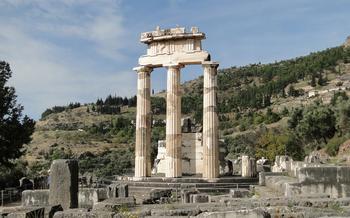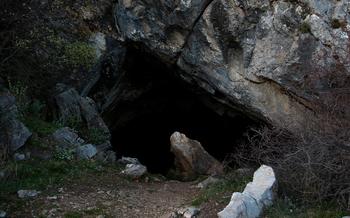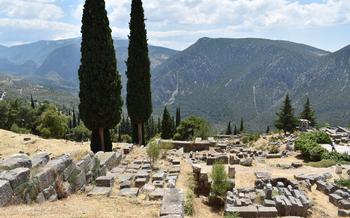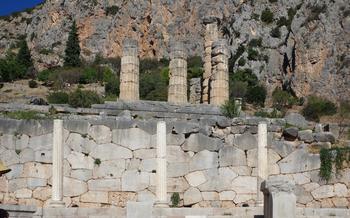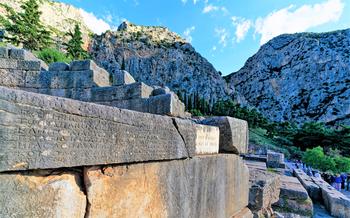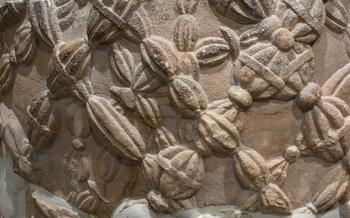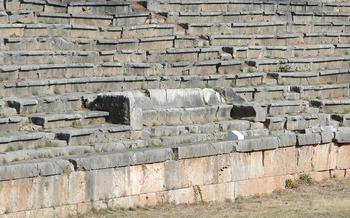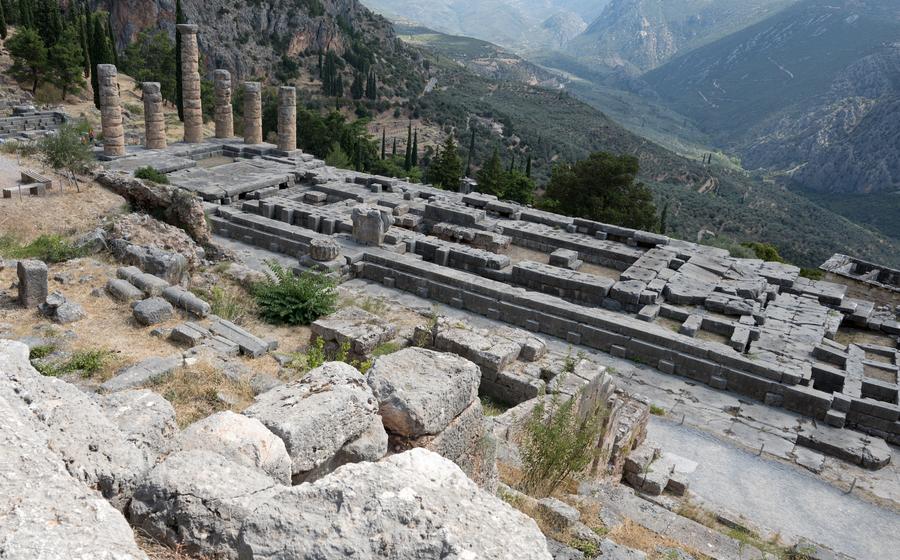
Temple of Apollo
- Delphi: A Sacred Place in Ancient Greece
- Temple of Apollo: Center of the Ancient World
- Exploring the Temple Complex
- The Oracle of Delphi: Unveiling the Mysteries
- Delphi Archaeological Museum: A Treasure Trove of Artifacts
- The Castalian Spring: A Sacred Water Source
- Mount Parnassus: A Majestic Natural Setting
- The Sacred Way: A Path of Pilgrims
- Delphi Festivals and Events: Reviving Ancient Traditions
- Tips for an Enriching Visit
- Nearby Attractions and Day Trips
- Capturing the Essence of Delphi
- Delphi in Literature, Art, and Mythology
- Insider Tip: Unveiling Hidden Gems
Delphi: A Sacred Place in Ancient Greece
Nestled among the majestic peaks of Mount Parnassus, Delphi holds a profound significance in the annals of ancient Greek history and mythology. Revered as the center of the world, this sacred site was believed to be the dwelling place of the revered god Apollo and the home of his renowned oracle.
Throughout antiquity, Delphi served as a spiritual and political focal point, attracting pilgrims, statesmen, and ordinary citizens seeking guidance and prophecies from the enigmatic oracle. Its enduring legacy as a sanctuary, a place of worship, and a symbol of unity has earned Delphi a well-deserved place as a UNESCO World Heritage Site.
Located in central Greece, approximately 180 kilometers northwest of Athens, Delphi's strategic position allowed it to become a pivotal crossroads of ancient Greece. Its proximity to the Gulf of Corinth and the fertile plains of Phocis contributed to its prominence as a thriving religious and commercial center.
Temple of Apollo: Center of the Ancient World
At the heart of the sacred precinct of Delphi lies the majestic Temple of Apollo, an architectural marvel that once served as the epicenter of the ancient world. Constructed in the 6th century BC, the temple stands as a testament to the architectural prowess and religious fervor of the ancient Greeks.
The temple's Doric columns, intricately adorned with sculptures and friezes, convey a sense of grandeur and awe. Inside the temple, a colossal statue of Apollo, the patron god of Delphi, once stood, radiating divine power and majesty.
Beyond its architectural splendor, the Temple of Apollo held profound religious significance. It was here that the Oracle of Delphi, revered throughout the ancient world, delivered prophecies and guidance to those seeking divine wisdom. The temple served as a sacred meeting ground, where people from across the Greek world and beyond flocked to seek counsel and divine intervention.
Exploring the Temple Complex
At the heart of Delphi lies the sacred precinct of Apollo, an awe-inspiring complex that showcases the architectural brilliance of ancient Greece. The main temple, dedicated to Apollo, stands as the centerpiece of the sanctuary. Its imposing Doric columns, meticulously carved pediments, and grand proportions exude an aura of majesty and divinity.
Surrounding the temple are a myriad of other significant buildings and monuments that contribute to the site's rich tapestry. The Treasury buildings, once used to store offerings and dedications from various Greek city-states, showcase diverse architectural styles and intricate decorative elements. The Tholos of Delphi, a circular building with a conical roof, is a marvel of engineering and a testament to the ingenuity of ancient architects.
As you wander through the temple complex, take time to appreciate the intricate details and symbolism embedded in each structure. From the friezes depicting mythological scenes to the inscriptions that reveal ancient stories and beliefs, every corner of the site holds hidden treasures waiting to be discovered.
The Oracle of Delphi: Unveiling the Mysteries
The enigmatic figure of the Oracle of Delphi was at the heart of the temple's fame and influence. The oracle, known as the Pythia, was a priestess chosen from the local community for her purity and piety. She delivered prophecies and guidance to those who sought her wisdom, including kings, statesmen, and ordinary people.
The process of consulting the oracle was elaborate and involved a series of rituals. The seeker would present an offering and make a sacrifice to Apollo, typically a goat or lamb. The Pythia would then enter a trance-like state, inhaling vapors from a chasm in the temple's inner sanctum. In this state, she would utter cryptic and ambiguous prophecies, which were interpreted by the temple priests.
The oracle's influence extended far beyond Delphi, reaching across the Greek world and beyond. Her prophecies guided political decisions, influenced military campaigns, and shaped the course of history. The oracle's prestige was such that even foreign rulers, such as the Roman emperor Nero, sought her advice.
However, the oracle's power gradually declined over time. With the rise of Christianity and the decline of the ancient Greek religion, the oracle's influence waned. The temple was eventually closed in the 4th century AD by the Roman emperor Theodosius I, marking the end of an era. Despite its demise, the legacy of the Oracle of Delphi continues to captivate and intrigue people to this day.
Delphi Archaeological Museum: A Treasure Trove of Artifacts
Delphi's archaeological museum stands as a testament to the cultural and artistic achievements of ancient Greece, housing an extensive collection of artifacts unearthed from the sacred site and its surroundings. As you step into the museum's galleries, you embark on a journey through time, surrounded by exquisite sculptures, pottery, and jewelry that bring the past vividly to life.
Among the museum's highlights is the awe-inspiring Charioteer of Delphi, a bronze statue that once adorned the Sanctuary of Apollo. With its intricate details and lifelike expression, this masterpiece captures the essence of ancient Greek craftsmanship. The museum also boasts an impressive collection of pottery, ranging from humble household vessels to elaborately decorated vases adorned with mythological scenes.
As you explore further, you'll encounter a dazzling array of jewelry, including delicate gold earrings, intricate necklaces, and precious gemstones. These adornments speak to the artistry and love of beauty that permeated ancient Greek society. Each artifact in the museum offers a glimpse into the lives, beliefs, and rituals of the ancient Greeks, providing a deeper understanding of their rich and vibrant culture.
The Castalian Spring: A Sacred Water Source
Nestled at the foot of Mount Parnassus, the Castalian Spring holds a profound significance in Greek mythology and culture. Considered a sacred water source, it was revered as a place of purification and cleansing for those seeking divine guidance and inspiration. According to legend, the spring was created when the hooves of the winged horse Pegasus struck the ground, unleashing a stream of pure water.
In ancient times, pilgrims and worshippers would make their way to the Castalian Spring before entering the Temple of Apollo. They believed that drinking from its waters or washing their hands and faces would cleanse them of any impurities, both physical and spiritual. The spring was also associated with Apollo's sister, the goddess Artemis, who was often depicted as bathing in its refreshing waters.
The Castalian Spring's connection to Apollo and the Muses, who were said to reside on Mount Parnassus, further enhanced its sacred status. Poets and musicians would often visit the spring to seek inspiration and creativity, believing that its waters held the power to unlock their artistic potential. The spring's symbolism of purity and enlightenment made it a fitting source of inspiration for those seeking divine guidance and creative expression.
Mount Parnassus: A Majestic Natural Setting
Beyond the sacred precinct of Delphi lies Mount Parnassus, a majestic natural landmark that serves as a stunning backdrop to the ancient ruins. Towering over the landscape, this mountain range offers breathtaking views and a serene natural setting that complements the historical significance of the site.
Hikers and nature enthusiasts will find Mount Parnassus a paradise, with well-marked trails that wind through dense forests, past cascading waterfalls, and up to panoramic viewpoints. The surrounding scenery is a tapestry of verdant valleys, rugged cliffs, and distant mountain peaks, creating a picture-perfect backdrop for exploration.
The mountain is also home to the ancient theater and stadium of Delphi, where athletic competitions and dramatic performances were once held. These structures, nestled amidst the natural beauty of Mount Parnassus, offer a glimpse into the cultural and sporting traditions of ancient Greece.
In Greek mythology, Mount Parnassus was considered the home of the Muses, the nine goddesses who inspired creativity and knowledge. It was also associated with Dionysus, the god of wine and revelry, who was said to roam the mountain slopes with his entourage of nymphs and satyrs. These mythical connections add an extra layer of enchantment to the natural wonders of Mount Parnassus.
The Sacred Way: A Path of Pilgrims
The Sacred Way, a processional route of immense significance, served as a gateway for pilgrims and visitors to the ancient sanctuary of Delphi. This path, lined with an array of monuments and statues, was a testament to the sacredness and reverence surrounding the site.
As pilgrims embarked on their journey along the Sacred Way, they were greeted by a series of impressive monuments and statues, each holding its own unique story. These monuments, crafted with intricate detail, depicted scenes from Greek mythology, honoring the gods and goddesses who held sway over Delphi.
The Sacred Way played a pivotal role in religious ceremonies and festivals held at Delphi. During the Pythian Games, athletes, musicians, and poets from across the Greek world converged on this path, showcasing their talents and seeking the favor of the gods.
The Sacred Way served as a tangible connection between Delphi and other sacred sites in the region. It extended beyond the sanctuary, linking Delphi to the nearby Castalian Spring and the Corycian Cave, both imbued with their own religious significance.
Walking along the Sacred Way today, visitors can experience a palpable sense of history and spirituality. The remnants of ancient monuments and statues, bathed in the warm glow of the Mediterranean sun, transport visitors back in time to an era when gods and mortals intertwined, and Delphi stood as a beacon of spiritual enlightenment.
Delphi Festivals and Events: Reviving Ancient Traditions
Delphi, the sacred site of ancient Greece, continues to pulsate with life and energy through its vibrant festivals and events. From ancient times, Delphi served as a stage for grand celebrations and religious ceremonies. Today, the spirit of these ancient gatherings is revived through modern cultural events, performances, and festivals.
The most renowned festival of ancient Delphi, the Pythian Games, was a symbol of unity and peace among the Greek city-states. Held every four years, the games featured athletic competitions, musical performances, and artistic contests. In the modern era, the Pythian Games have been revived as the Delphi Festival, a prestigious cultural event that attracts artists and performers from around the world.
Music lovers can immerse themselves in the enchanting melodies of the Delphi Music Festival, held annually against the backdrop of the ancient theater. This festival showcases a diverse range of musical genres, from classical to contemporary, creating a harmonious fusion of ancient and modern sounds.
Delphi also hosts various other cultural events throughout the year, including art exhibitions, theater performances, and lectures. These events provide a platform for contemporary artists and scholars to showcase their work and engage in dialogue with the public.
Attending a festival or event in Delphi is a unique opportunity to experience the site's vibrant atmosphere and connect with its rich cultural heritage. Immerse yourself in the music, art, and performances that bring the spirit of ancient Delphi to life.
Tips for an Enriching Visit
To make the most of your visit to Delphi, keep these tips in mind:
-
Plan your visit during the shoulder season (April-May and September-October): During these months, the weather is pleasant, and the crowds are smaller.
-
Arrive early to avoid the crowds: Delphi is a popular tourist destination, and it can get crowded, especially during the summer months. Aim to arrive early in the morning to beat the crowds and enjoy a more peaceful visit.
-
Wear comfortable shoes for walking: You'll be doing a lot of walking at Delphi, so make sure to wear comfortable shoes. The ancient site is set on a hillside and involves uneven surfaces and steps.
-
Bring water and sun protection: Delphi is located in a sunny region of Greece, so it's essential to bring water and sun protection, especially during the summer months.
Nearby Attractions and Day Trips
Delphi's strategic location in Central Greece makes it an ideal base for exploring other captivating destinations. Just a short drive away, immerse yourself in the ancient wonders of Corinth, where the ruins of the Temple of Apollo and the iconic Isthmus await. Discover the awe-inspiring Meteora Monasteries, perched atop towering rock formations, offering breathtaking views and a glimpse into Greece's rich religious history. Delve into the heroic tales of ancient Greece at Thermopylae, where the legendary Battle of 300 took place. Embrace the picturesque landscapes of the surrounding countryside, dotted with quaint villages, olive groves, and stunning vistas. Whether you seek cultural immersion, natural beauty, or a journey through history, Delphi offers a wealth of nearby attractions to enhance your Greek adventure.
Capturing the Essence of Delphi
Delphi, steeped in history and myth, offers a feast for the eyes and a profound connection to the past. Capturing the essence of this sacred place through photography requires not just technical skill but also a deep appreciation for its spiritual and cultural significance.
When photographing Delphi, embrace the golden hours of sunrise and sunset to bathe the ruins in a warm, ethereal glow. Experiment with different angles to create dynamic compositions, using the surrounding mountains and valleys as a majestic backdrop.
Focus on the details—the intricate carvings on the Temple of Apollo, the worn steps of the Sacred Way, and the serene beauty of the Castalian Spring. These elements tell a story of a civilization that revered nature, sought divine guidance, and celebrated artistic excellence.
Delphi's essence lies not only in its physical remains but also in its intangible aura. Strive to capture the spirit of the place—the tranquility of the olive groves, the echoes of ancient rituals, and the sense of awe that pilgrims must have felt as they approached the oracle.
Share your photographs with the world, allowing others to experience the magic of Delphi through your lens. Your images can become a testament to the enduring power of this sacred place, inspiring future generations to explore its wonders and delve into its captivating history.
Delphi in Literature, Art, and Mythology
Delphi's profound influence extended beyond the realm of religion and politics, deeply embedding itself in the cultural fabric of ancient Greece. It served as an inspiration for poets, playwrights, and artists, who immortalized its significance in their works. Homer, in his epic masterpiece, the Iliad, referred to Delphi as the "navel of the world," highlighting its central position in the Greek consciousness.
In art, Delphi was often depicted as a sacred landscape, with the Temple of Apollo taking center stage. Paintings and sculptures captured the awe-inspiring grandeur of the site, showcasing the intricate details of its architecture and the serene beauty of its surroundings.
Myths and legends also intertwined with the history of Delphi. It was believed to be the birthplace of Apollo, the god of music, prophecy, and healing, who slew the monstrous serpent Python at the site. The oracle of Delphi was said to have been established by Apollo himself, cementing its divine connection.
Exploring the literary, artistic, and mythological representations of Delphi offers a deeper understanding of its cultural significance and the enduring legacy it left on ancient Greek civilization.
Insider Tip: Unveiling Hidden Gems
Beyond the main attractions, Delphi offers a wealth of hidden gems that await discovery. As you explore the site, keep an eye out for lesser-known corners that reveal the rich history and spirituality of this sacred place.
Look for ancient inscriptions and carvings etched into the stones, telling stories of past pilgrims and prophecies. Seek out the tranquility of the Olive Grove of Athena Pronaia, located just outside the main archaeological site. This serene grove, with its ancient olive trees and stunning views, offers a peaceful retreat from the hustle and bustle of the main tourist areas.
As you immerse yourself in the magic of ancient Delphi, take the time to appreciate the finer details and hidden treasures that make this place so unique. Embrace the spirit of exploration and allow yourself to be captivated by the enduring legacy of this sacred sanctuary.
